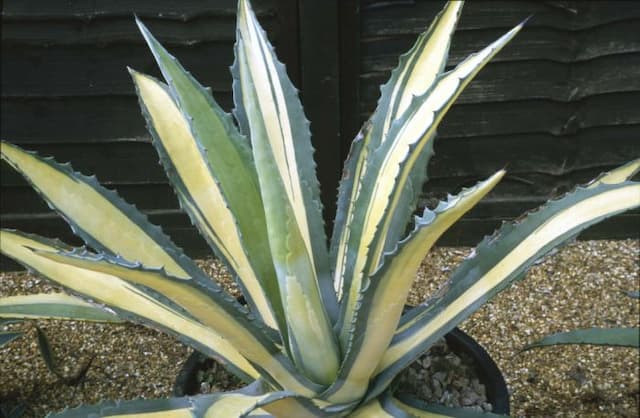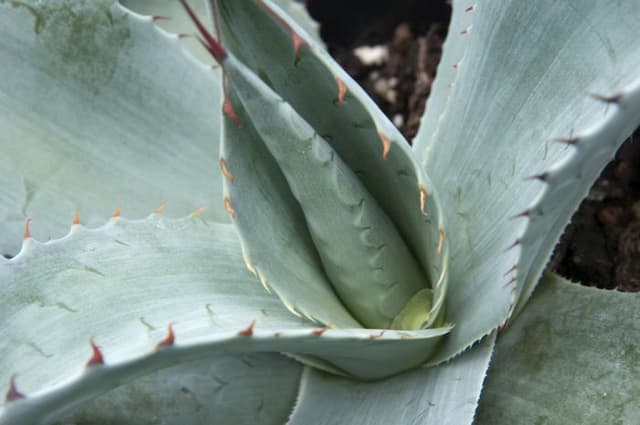Pineapple lily Eucomis comosa

ABOUT
Commonly known as the pineapple lily, the appearance of this plant is quite striking and unique. The foliage consists of a rosette of long, strap-like leaves that are glossy with a slightly wavy edge. The color of the leaves can vary from deep green to sometimes having purplish or maroon tinges, especially along the margins. The most distinctive feature of the pineapple lily is its flower stalk. The stalk is topped with a dense cluster of star-shaped flowers that have a look reminiscent of the top of a pineapple, hence its common name. These flowers are typically creamy white but may have hints of green or purple. Just above the flowers, there is a tuft of leaf-like bracts that can range in color from green to deep purple, enhancing the pineapple effect. The overall impression of the pineapple lily is exotic and lush, with the floral display being particularly eye-catching. The plant has a bold texture and can be a stand-out feature in a garden due to its unique floral structure.
About this plant
 Names
NamesFamily
Asparagaceae.
Synonyms
Pineapple Lily, Pineapple Flower, Wine Eucomis.
Common names
Eucomis punctata, Eucomis regia, Anthericum comosum, Eucomis autumnalis.
 Toxicity
ToxicityTo humans
The pineapple lily (Eucomis comosa) has parts that are considered to potentially be toxic if ingested. While there is not a considerable amount of documentation on the specific symptoms in humans, it is advised to avoid consuming this plant. As with many plants that are potentially toxic, ingestion could potentially lead to symptoms such as nausea, vomiting, and diarrhea. In severe cases, more serious symptoms could occur, so it is best to prevent any ingestion and seek medical advice if exposure occurs.
To pets
The pineapple lily (Eucomis comosa) may be toxic to pets if ingested. While specific research on the level of toxicity to pets such as dogs and cats is limited, it is generally advisable to prevent your pets from consuming any part of the plant. Symptoms of poisoning could include gastrointestinal upset, such as vomiting and diarrhea. In the event that a pet ingests part of a pineapple lily, it is important to consult a veterinarian as they may require supportive care or treatment depending on the severity of the symptoms.
 Characteristics
CharacteristicsLife cycle
Perennials
Foliage type
Deciduous
Color of leaves
Green
Flower color
Varies
Height
1-2 feet (30-60 cm)
Spread
1 foot (30 cm)
Plant type
Bulb
Hardiness zones
7-10
Native area
South Africa
Benefits
 General Benefits
General Benefits- Aesthetic Appeal: Eucomis comosa, commonly known as the Pineapple Lily, has a unique and striking appearance with a rosette of wide leaves and a tall flower spike resembling a pineapple, adding an exotic touch to gardens and landscapes.
- Easy to Grow: Pineapple Lily is relatively low-maintenance and can thrive with minimal care, which makes it suitable for gardeners of all skill levels.
- Attracts Pollinators: The flowers of Pineapple Lily attract bees, butterflies, and other pollinators, which are beneficial for the garden ecosystem.
- Drought Tolerance: Once established, Pineapple Lily exhibits good drought tolerance, making it a suitable choice for water-wise gardens and regions with water restrictions.
- Long Blooming: The plant has a long blooming period during the summer months, providing color and interest in the garden when many other plants have finished flowering.
- Container Gardening: Eucomis comosa can be grown in containers, which allows for flexibility in placement and is ideal for those with limited garden space.
- Cut Flowers: The blooms make excellent and long-lasting cut flowers for indoor arrangements, bringing a unique aesthetic to floral designs.
- Deer Resistance: Pineapple Lily is less attractive to deer than many other garden plants, reducing the likelihood of damage from browsing animals.
 Medical Properties
Medical Properties- Traditional use for headaches: In some traditional medicine systems, Eucomis comosa has been used to relieve headaches.
- Anti-inflammatory properties: Compounds extracted from the plant may have anti-inflammatory effects.
- Pain relief: It has been used as a topical application for pain relief in some cultures.
- Digestive aid: There is ethnobotanical evidence for its use in aiding digestion.
- Antimicrobial activity: Studies have indicated that extracts may possess antimicrobial properties against certain pathogens.
 Air-purifying Qualities
Air-purifying QualitiesThis plant is not specifically known for air purifying qualities.
 Other Uses
Other Uses- Pineapple lily can be used as ornamental focal points in garden beds, with their distinctive flower spikes and rosette of leaves adding an exotic touch.
- The flowers of the pineapple lily can serve as a long-lasting cut flower for bouquets and flower arrangements due to their durability and unique appearance.
- In garden ponds or water features, pineapple lily can be planted at the edges to add vertical interest and an architectural element.
- These plants can be used in container gardens, either alone or mixed with other plants, to create interesting displays on patios or balconies.
- Pineapple lily's unique flower structure can be an educational tool for botany enthusiasts to learn about different flowering mechanisms and structures.
- The dried seed heads of pineapple lilies can be used in dried flower arrangements or as part of craft projects because they retain their shape and form.
- Landscape designers can use the pineapple lily as a textural contrast to fine-leaved plants in garden design to create a diverse visual tapestry.
- The leaves of the pineapple lily can be used as a natural green backdrop in photography, especially macro photography, to highlight smaller subjects.
- In theme gardens, such as a tropical or subtropical garden, pineapple lilies can be included to reinforce the thematic visual elements.
- Pineapple lily can be planted along walkways or garden paths to guide the eye and lead visitors through the garden landscape.
Interesting Facts
 Feng Shui
Feng ShuiThe Pineapple Lily is not used in Feng Shui practice.
 Zodiac Sign Compitability
Zodiac Sign CompitabilityThe Pineapple Lily is not used in astrology practice.
 Plant Symbolism
Plant Symbolism- Exotism: Eucomis comosa, commonly known as Pineapple Lily, often represents exotic beauty due to its unusual flower shape and resemblance to a tropical pineapple.
- Striking Appearance: The striking bloom and unique foliage pattern symbolizes individuality and a stand-out nature, making it a symbol for those who want to make an impression.
- Curiosity: The Pineapple Lily can also symbolize curiosity, as it draws attention and sparks interest due to its peculiar tropical appearance, despite not being related to actual pineapples.
- Hospitality: Similar to pineapples, the Pineapple Lily can be associated with hospitality and warm welcomes, since pineapples are a traditional symbol of friendship and hospitality.
 Water
WaterPineapple lily (Eucomis comosa) prefers consistent moisture during its active growth period. It's best watered thoroughly once the top inch of the soil feels dry to the touch. Typically, this may be about once a week, but it can vary depending on temperature and humidity. Water the plant with a gentle stream, avoiding waterlogging, until excess water drains from the bottom of the pot. During the dormant season, reduce watering significantly, providing maybe a few onzes every couple of weeks to prevent the soil from becoming bone dry.
 Light
LightPineapple lily thrives best in full sun to partial shade. Choose a location where the plant can receive at least six hours of direct sunlight daily. However, in hot climates, protection from intense afternoon sun will prevent leaf scorch. A spot that offers morning sunlight with dappled shade in the afternoon is ideal.
 Temperature
TemperaturePineapple lilies enjoy warm temperatures and do not do well in cold weather. The ideal temperature range for thriving growth is between 60 and 75 degrees Fahrenheit. They can tolerate temperatures down to about 50 degrees Fahrenheit, but anything below that can be harmful. During the winter, if grown outdoors, they should be protected or moved inside if temperatures are expected to drop below the minimum threshold.
 Pruning
PruningPineapple lily benefits from pruning primarily to remove spent flowers and any yellowing or dead foliage. Deadheading after flowering encourages the plant to store energy for the next season. Cut back the flower stalks at the base once they have finished, and trim off any undesirable leaves. The best time for pruning is late summer after blooming, or as necessary for maintenance.
 Cleaning
CleaningAs needed
 Soil
SoilPineapple lily thrives best in a soil mix with good drainage, composed of two parts loam, one part sand, and one part compost. The ideal soil pH for this plant should range between 6.0 to 7.0 to promote healthy growth.
 Repotting
RepottingPineapple lilies should be repotted every 2 to 3 years, or when the pot becomes crowded. This typically occurs when the bulbs multiply or the plant outgrows its current pot size.
 Humidity & Misting
Humidity & MistingPineapple lily prefers moderate humidity levels but is adaptable to average home humidity conditions. There is no need for extra humidity measures as the plant is quite tolerant.
 Suitable locations
Suitable locationsIndoor
Place Pineapple lily in bright, indirect light indoors.
Outdoor
Plant Pineapple lily in a sunny spot with some afternoon shade.
Hardiness zone
7-10 USDA
 Life cycle
Life cycleThe life cycle of Eucomis comosa, commonly known as Pineapple Lily, begins with seed germination, which occurs in moist, well-drained soil under warm conditions. Once germinated, the seedling emerges and develops into a rosette of strap-like leaves during its growth phase. As the plant matures, it develops a thickened bulb underground that stores nutrients for the next season. In summer, Pineapple Lily produces a distinctive flower spike resembling a pineapple, with star-shaped flowers arranged in a dense raceme atop a tall stem. After flowering, the plant sets seed, which can be dispersed to propagate new plants. During the dormant season, the above-ground foliage dies back, and the plant survives as a bulb until favorable growth conditions return.
 Propogation
PropogationPropogation time
Spring-Early Summer
Propogation: The most popular method of propagating the pineapple lily (Eucomis comosa) is through bulb division. The best time for propagation is in the spring, as the plant is emerging from dormancy. To propagate by dividing, carefully unearth the parent bulb once the threat of frost has passed. You will often find small bulblets, or offsets, attached to the base of the main bulb. These can be gently separated and replanted. Each offset should be planted in well-draining soil, around 4 to 5 inches (10 to 12.7 centimeters) deep, spaced about 12 inches (30.48 centimeters) apart to ensure sufficient room for growth. After planting, water the offsets thoroughly to help establish them in their new location.



![Beschorneria [Flamingo Glow]](/_next/image?url=https%3A%2F%2Fplants-admin.emdemapps.com%2Fimages%2Fplants%2F%2Fimages%2F604b59df2e78d.png&w=640&q=75)




